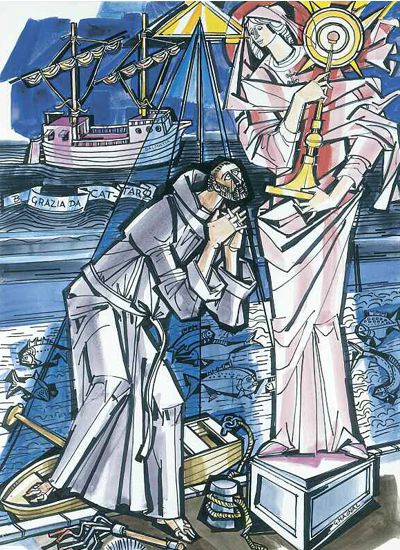
Blessed Gratia of Cattaro - 7th November
He was born into a family of seafarers and thus, when he was old enough to join his father, this was his work until he reached the age of 30 years. After all, he was following the same sort of life as other youths from the city of his birth. Mulla, a small village close to Cattaro in Dalmania, today part of Montenegro. This sort of life engendered in him a spirit of diligence and love for work. However, this also had the perils of low morals that used to prick Gratia’ conscience. In fact, it was after he had heard one of the moving sermons of the Augustinian Peter from Camerino, founder of the Congregation of the Osservanza of Monte Ortone, that Gratia decided not only to change his life, but also to give himself up totally to the service of God.
In this respect he imitated St. Augustine who, on his conversion, was not content only to be baptised but also wanted to give his life as a servus Dei.. Therefore, Gratia left behind him a seafaring life and made his way to Monte Ortone, close to Padova, where he embraced Augustian life as a novice friar, one of the religious brethren. In those days there were various congregations of the Osservanza that were established so as to recover the style of the original life of the Augustinian Order, which, with the passage of time, started to lose some of its charismatic spirit with which it was established in 1244.
In the community, despite the fact that he had entered as an adult and he had experienced the life of a seafarer, Fra. Gratia adjusted himself not only to a new style of life, but he excelled over the others as regards the observance of religious rules and Christian virtues. He learnt how to pray seriously. An intimate life with God led him endlessly towards the spiritual consolation that he used to receive in moments of contemplation. However, this contemplation – in a genuine Augustinian spirit – was always on a firm foothold. Fra Gratia, being a diligent man, did not hesitate to offer his services for whatever was required at his convent that was in the common interest of the community.
His services were called for in various convents; this is the way he lived his life, serving his fellow friars in a spirit of humility, prayer, penance and observance of the Augustinian Rule. He died at the convent of St. Christopher of Peace on the island of Murano, Venice on 9 November 1508. His fame and holiness were bound to draw a great number of devotees who had, and still have, recourse to him for his intercession. As from 1810, his remains are to be found in the city of his birth, Mulla. His cult is a strong one and every year, great feasts are celebrated in his remembrance.
Blessed Gratia remains a living example of how a life of work and diligence is the road that leads to holiness. What is important is not the work that one performs, but the spirit with which this is done; with fidelity to God’s call and with love for the common good.

